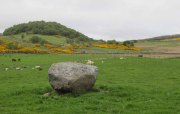Standing Stones (destroyed): OS Grid Reference – NC 582 541
Also Known as:
Archaeology & History
When I visited this place last year, I had a good look all around for any trace of what James Horsburgh (1870) told us about 150 years earlier, i.e., monoliths that had been broken up and used in the making of the road. Sadly I found nothing. When I enquired about the stones amongst local people, they were unaware of any such site and it had fallen out of oral tradition amongst them. Mr Horsburgh told us simply:
“Near Ribegal there used to be three upright stones, called by the old people a Teampul. They were broken up by Mr Mitchell, the late farmer, and are now built into the dyke at the road side; the hillock on which they stood is still called Croc-tigh-goil, the ‘hillock of the school-house’.”
However, in the fields 300 yards to the north, three large stones are visible—almost in a straight line—but they seem to be Nature’s handiwork; although the southernmost stone looks like it might once have stood upright. But I think I’m being more hopeful than realistic!
References:
- Horsburgh, James, “Notes of Cromlechs, Duns, Hut-circles, Chambered Cairns and other Remains, in the County of Sutherland“, in Proceedings Society of Antiquaries, Scotland, volume 7, 1870.
© Paul Bennett, The Northern Antiquarian
The map could not be loaded. Please contact the site owner.
